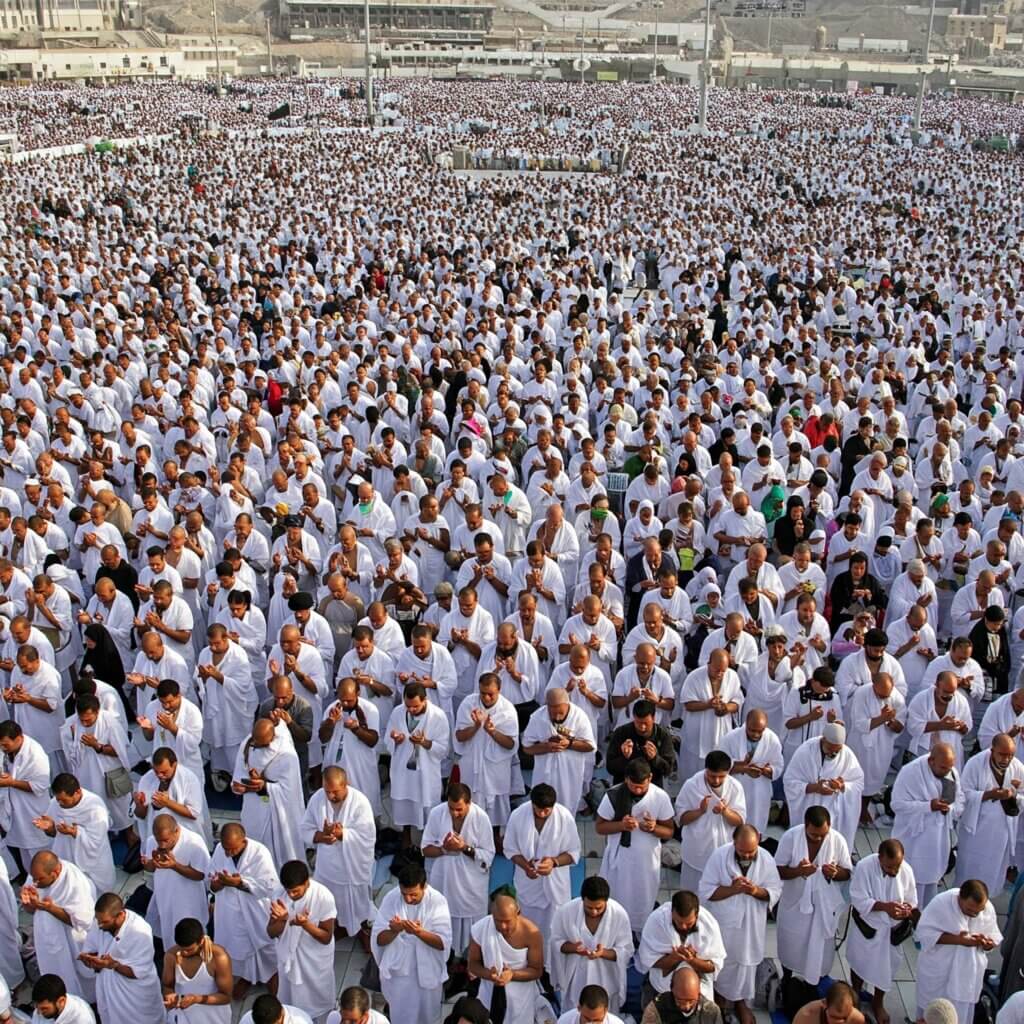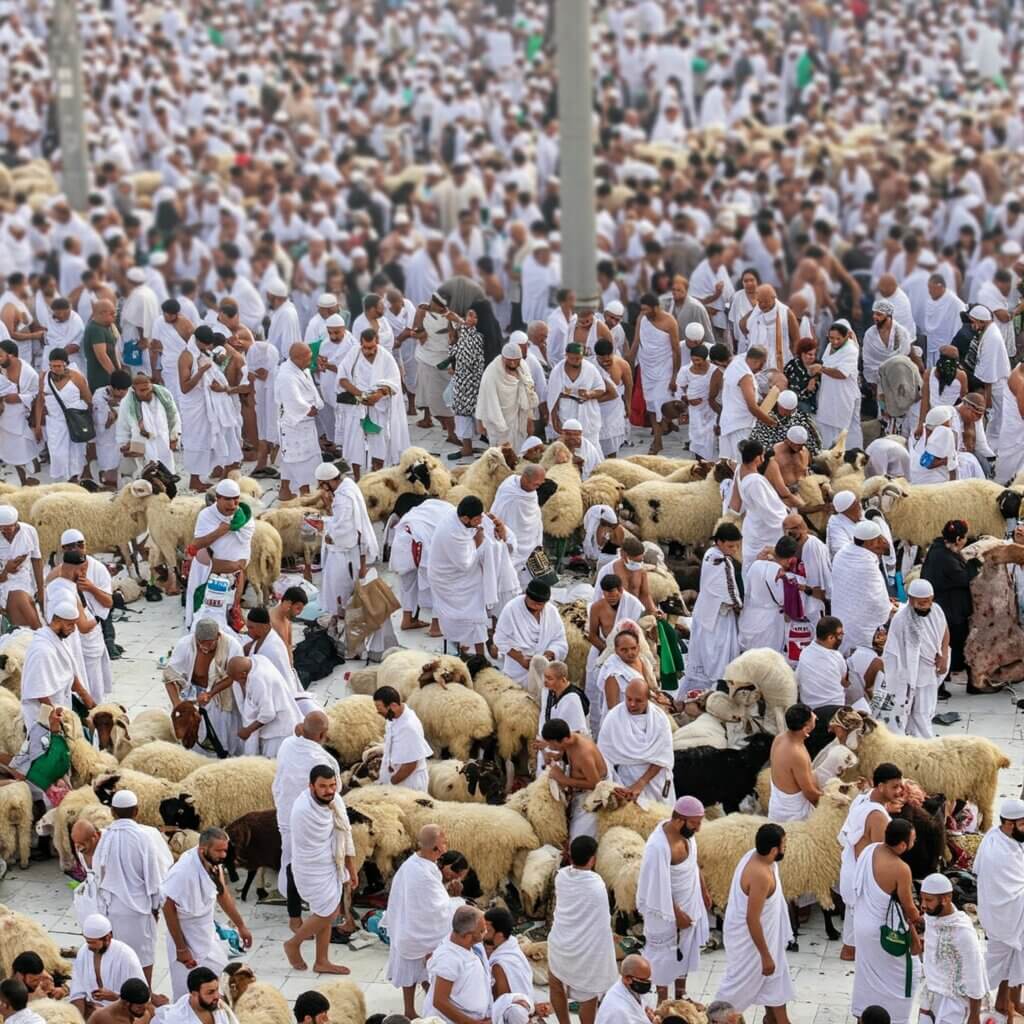Hajj and Umrah in Islam: Understanding the Rituals and Key Differences
Introduction
The rituals of Hajj (the major pilgrimage) and Umrah (the minor pilgrimage) hold a profound place in the hearts of Muslims worldwide. They represent not only a religious duty and an opportunity for spiritual purification but also embody the unity of the Muslim Ummah (community) and serve as a reminder of the ancient history of Islam dating back to the time of Prophet Ibrahim (Abraham), peace be upon him.
Hajj, the fifth pillar of Islam, is an obligatory duty (Fard ‘ayn) for every adult, sane, and capable Muslim once in their lifetime. Umrah, although its obligation is subject to differing scholarly opinions, remains a highly virtuous ritual that Muslims undertake to draw closer to Allah Almighty.
Understanding the intricacies of the Hajj and Umrah rituals (Manasik) and recognizing the subtle differences between them is crucial, not only for those performing these acts of worship but also for researchers in Islamic studies and religious anthropology. This article aims to bridge potential knowledge gaps by presenting a systematic and scholarly overview of these rituals and their distinctions, based on authentic religious texts and established practices, presented in a professional, academic style suitable for informative platforms.
First: Hajj – Definition, Significance, and Rituals
1. Linguistic and Terminological Definition:
- Linguistically: The Arabic word “Hajj” means to intend or purpose towards something revered.
- Terminologically (Sharia): It signifies intending to visit the Sacred House of Allah (the Ka’bah in Makkah) at a specific time to perform specific acts of worship according to specific conditions. It is an individual obligation established by the Quran, the Sunnah (Prophetic tradition), and scholarly consensus (Ijma’). Allah Almighty says: {And [due] to Allah from the people is a pilgrimage to the House – for whoever is able to find thereto a way.} (Quran, Surah Aal-Imran, 3:97)
2. Spiritual and Social Significance:
- Spiritual: Hajj is a profound journey of faith aimed at purifying the soul, expiating sins, and renewing one’s covenant with Allah. Muslims stand on the plain of Arafat in an awe-inspiring scene reminiscent of the Day of Judgment, stripped of worldly adornments, equal before their Creator.
- Social: Hajj represents the largest annual human gathering globally. Muslims from all corners of the earth converge, regardless of color, language, or ethnicity, reinforcing the bonds of brotherhood, equality, and Islamic unity.
3. Types of Hajj:
Before starting the rituals, a pilgrim chooses one of three types (Nusuk):
- Tamattu’: The pilgrim assumes Ihram (state of consecration) for Umrah during the Hajj months (Shawwal, Dhu al-Qi’dah, Dhu al-Hijjah), performs its rituals, then exits the state of Ihram. They remain in Makkah until the 8th of Dhu al-Hijjah (Yawm al-Tarwiyah), when they assume Ihram again, this time for Hajj, from their location in Makkah and perform its rituals. This type requires offering a Hady (sacrificial animal, e.g., a sheep).
- Qiran: The pilgrim assumes Ihram for both Umrah and Hajj simultaneously, or assumes Ihram for Umrah and then incorporates the intention for Hajj before starting the Tawaf (circumambulation) of Umrah. The pilgrim remains in Ihram until the Day of Sacrifice (Yawm al-Nahr, 10th Dhu al-Hijjah). This type also requires offering a Hady.
- Ifrad: The pilgrim assumes Ihram for Hajj only from the designated Miqat (boundary station). They remain in Ihram until the Day of Sacrifice. No Hady is required for this type.

4. Hajj Rituals (Chronological Order):
Hajj rituals consist of Pillars (Arkan), Obligatory acts (Wajibat), and Recommended acts (Sunan).
- Pillars (Arkan): Essential components; Hajj is invalid without them.
- Obligatory acts (Wajibat): Required acts; if omitted, Hajj is still valid, but a penalty (Damm – offering a sacrifice) is required.
- Recommended acts (Sunan): Actions rewarded if performed, but no penalty if omitted.
A. Ihram (Pillar – Rukn):
- Niyyah (Intention): Firmly intending in the heart to enter the state of consecration for Hajj, Umrah, or both.
- Miqat (Boundary Station): Designated locations where pilgrims must assume Ihram based on their origin (e.g., Dhul-Hulayfah for Madinah, Al-Juhfah for Syria/Egypt/Maghreb, Qarn al-Manazil for Najd, Yalamlam for Yemen, Dhat Irq for Iraq). Those residing within the Miqat boundaries assume Ihram from their place of residence. Residents of Makkah assume Ihram for Hajj from Makkah itself. * Talbiyah: Reciting the call: “Labbayka Allahumma Labbayk, Labbayka la sharika laka Labbayk, Innal-hamda wan-ni’mata laka wal-mulk, la sharika lak.” (Here I am, O Allah, 1 here I am. Here I am, You have no partner, here I am. Verily, all praise, grace, and 2 sovereignty belong to You. You have no partner.)
- Prohibitions of Ihram: While in Ihram, certain actions are forbidden, including: wearing stitched clothing (for men), covering the head (for men), covering the face with a Niqab (for women, though they should lower a covering over their faces in the presence of non-Mahram men), cutting hair or nails, using perfume, hunting, contracting marriage, and sexual intercourse or acts leading to it.
B. Tawaf (Circumambulation):
- Tawaf al-Qudum (Arrival Tawaf): Sunnah for Qarin and Mufrid pilgrims / Tawaf of Umrah: Pillar (Rukn) for Mutamatti’ pilgrims.
- Upon arriving in Makkah, pilgrims perform Tawaf around the Ka’bah seven times (circuits), starting and ending each circuit at the Black Stone (Al-Hajar al-Aswad). It is Sunnah for men to perform Raml (brisk walking with short steps) in the first three circuits and Idtiba’ (uncovering the right shoulder) throughout this Tawaf.
C. Sa’i between Safa and Marwa (Pillar – Rukn):
- After Tawaf, pilgrims proceed to the Mas’a (path for Sa’i) to walk back and forth between the two hillocks of Safa and Marwa seven times, starting at Safa and ending at Marwa. It is Sunnah for men to hasten their pace (Harwalah) between the green markers.
- (The Mutamatti’ performs Sa’i for their Umrah. The Qarin and Mufrid perform Sa’i for their Hajj, though they may delay it until after Tawaf al-Ifadah).
D. Yawm al-Tarwiyah (Day of Quenching Thirst – 8th Dhu al-Hijjah – Sunnah):
- Pilgrims in Ihram for Hajj (Mutamatti’ who re-entered Ihram, Qarin, and Mufrid) proceed to Mina in the morning. They pray Dhuhr, Asr, Maghrib, Isha, and Fajr prayers there (shortening the 4-unit prayers but praying each at its designated time). They spend the night preceding the 9th in Mina.
E. Standing (Wuquf) at Arafat (The Greatest Pillar of Hajj – Rukn – 9th Dhu al-Hijjah):
- After sunrise on the 9th, pilgrims move from Mina to the plain of Arafat. Standing at Arafat is the cornerstone of Hajj, as the Prophet Muhammad (peace be upon him) said: “Hajj is Arafat.” The time for Wuquf begins from noon (Zawal, Dhuhr time) on the Day of Arafat and extends until dawn on the Day of Sacrifice (10th Dhu al-Hijjah). Pilgrims spend this day in supplication (Du’a), remembrance of Allah (Dhikr), reciting Talbiyah, and reading the Quran. It is Sunnah to combine the Dhuhr and Asr prayers, praying them together at the time of Dhuhr (Jama’ Taqdim).
F. Spending the Night in Muzdalifah (Obligatory – Wajib):
- After sunset on the Day of Arafat, pilgrims proceed calmly and serenely to Muzdalifah. There, they combine the Maghrib and Isha prayers, praying them together at the time of Isha (Jama’ Ta’khir) with one Adhan and two Iqamas. They spend the night in Muzdalifah until Fajr prayer. It is recommended to engage in abundant Dhikr and Du’a near the Mash’ar al-Haram after Fajr. Pilgrims collect pebbles (Jamarat) here (70 pebbles, or 49 for those intending to leave early). Women, the weak, and the elderly are permitted to leave Muzdalifah for Mina after midnight.

G. Yawm al-Nahr (Day of Sacrifice – 10th Dhu al-Hijjah):
- This is the busiest day of Hajj. Pilgrims perform the following actions, ideally in this order (though performing them out of sequence is generally permissible according to the majority of scholars):
- Rami Jamrat al-Aqabah (Stoning the Major Pillar): Proceed to Mina to stone the largest Jamarah (Jamrat al-Aqabah) with seven pebbles, saying “Allahu Akbar” with each throw. The time for stoning begins from dawn on the 10th and extends to dawn the next day, but the Sunnah is to stone it in the forenoon (Duha).
- Nahr or Dhabh (Sacrifice – Obligatory for Tamattu’ and Qiran): Slaughtering the Hady (sacrificial animal: a sheep, or one-seventh of a camel or cow).
- Halq or Taqsir (Shaving or Trimming Hair – Obligatory): Men shave their heads completely (Halq, which is preferable) or trim their hair short (Taqsir). Women trim a small portion (fingertip’s length) from the ends of their hair. This completes the first stage of release from Ihram (Tahallul al-Asghar), allowing all previously prohibited actions except sexual intercourse.
- Tawaf al-Ifadah (Pillar – Rukn): Proceed to Makkah to perform Tawaf around the Ka’bah seven times. This is a pillar of Hajj.
- Sa’i (Pillar – Rukn for those who haven’t performed it yet or for Tamattu’): Perform Sa’i between Safa and Marwa if performing Tamattu’, or if performing Qiran or Ifrad and did not perform it after Tawaf al-Qudum.
- After Tawaf al-Ifadah (and Sa’i, if applicable), the pilgrim achieves the second and final stage of release (Tahallul al-Akbar), where all Ihram restrictions, including sexual intercourse, are lifted.
H. Ayyam al-Tashreeq (Days of Drying Meat – 11th, 12th, 13th Dhu al-Hijjah): 1. Staying in Mina (Obligatory – Wajib): Pilgrims spend these days (or most of them) in Mina. 2. Rami al-Jamarat (Stoning the Three Pillars): Each day (after Zawal – noon), pilgrims stone the three Jamarat (pillars): first the small (Sughra), then the medium (Wusta), and finally the large (Kubra/Aqabah). Each is stoned with seven pebbles, saying “Allahu Akbar” with each throw. It is Sunnah to make Du’a after stoning the small and medium Jamarat. 3. Hastening or Delaying Departure: Pilgrims may choose to leave Mina (Nafar) on the 12th after completing the stoning for that day and before sunset (Ta’ajjul – hastening). Those who stay until the 13th must stone all three Jamarat on that day as well before departing (Ta’akhkhur – delaying).
I. Tawaf al-Wada’ (Farewell Tawaf – Obligatory – Wajib):
- The last ritual performed before leaving Makkah is the Farewell Tawaf, circumambulating the Ka’bah seven times. It is obligatory for all pilgrims except for women during menstruation or post-natal bleeding.
Second: Umrah – Definition and Rituals
1. Definition:
- Linguistically: The Arabic word “Umrah” means a visit.
- Terminologically (Sharia): It signifies visiting the Sacred House of Allah (Ka’bah) in a specific manner, involving Tawaf around the House and Sa’i between Safa and Marwa while in a state of Ihram.
2. Religious Ruling:
- Scholars differ on its ruling. The Shafi’i and Hanbali schools view it as obligatory (Wajib) once in a lifetime, similar to Hajj. The Maliki and Hanafi schools consider it a highly emphasized Sunnah (Sunnah Mu’akkadah).
3. Rituals:
Umrah rituals are simpler and fewer than Hajj rituals, consisting only of:
- A. Ihram: Assuming the state of Ihram from the designated Miqat, or from the Hill (area outside the Haram sanctuary, like Tan’im or Ji’ranah) for those already within Makkah.
- B. Tawaf: Performing seven circuits around the Ka’bah.
- C. Sa’i: Performing seven laps between Safa and Marwa.
- D. Halq or Taqsir (Shaving or Trimming): Shaving or trimming the hair, which completes the Umrah and releases the pilgrim from the state of Ihram.
Third: Key Differences Between Hajj and Umrah
The fundamental distinctions between Hajj and Umrah can be summarized as follows:
- Religious Ruling:
- Hajj: Obligatory (Fard ‘ayn) once in a lifetime for those who are able. It is the fifth pillar of Islam.
- Umrah: Obligatory (Wajib) once according to some scholars (Shafi’i, Hanbali), or an emphasized Sunnah according to others (Maliki, Hanafi).
- Pillars and Obligations:
- Hajj: Has more Pillars (Ihram, Standing at Arafat, Tawaf al-Ifadah, Sa’i) and numerous obligatory acts (staying overnight in Muzdalifah and Mina, stoning the Jamarat, Halq/Taqsir, Farewell Tawaf).
- Umrah: Has fewer Pillars (Ihram, Tawaf, Sa’i). Its main obligations are Ihram from the Miqat and Halq/Taqsir (according to those who classify them as Wajib). It does not include Standing at Arafat, staying in Muzdalifah or Mina, or stoning the Jamarat.
- Timing:
- Hajj: Can only be performed during a specific, designated time: the Hajj months (Shawwal, Dhu al-Qi’dah, first ten days of Dhu al-Hijjah), with the core rituals concentrated between the 8th and 13th of Dhu al-Hijjah.
- Umrah: Can be performed at any time of the year. There is no specific season, although performing it during Ramadan holds special virtue.
- Location Scope:
- Hajj: Requires movement between several sacred sites: Makkah (Masjid al-Haram), Mina, Arafat, and Muzdalifah.
- Umrah: Its rituals are confined primarily to the Masjid al-Haram (for Tawaf) and the Mas’a (for Sa’i) within Makkah.
- Duration and Difficulty:
- Hajj: Takes several days to complete (at least 5-6 days) and involves greater physical exertion due to the numerous rituals and movements between locations.
- Umrah: Can be completed within a few hours and is considerably less strenuous than Hajj.
- Requirement of Hady (Sacrifice):
- Hajj: Offering a sacrifice (Hady) is obligatory for pilgrims performing Tamattu’ or Qiran types of Hajj.
- Umrah: Hady is generally not required unless the pilgrim violates an Ihram prohibition that necessitates it, or if they had made a vow (Nadhr) to offer one.
Conclusion
It is evident that both Hajj and Umrah are venerable acts of worship in Islam. They share certain rituals like Ihram, Tawaf, Sa’i, and Halq/Taqsir, but differ fundamentally in aspects related to religious ruling, timing, location, nature of rituals, and duration. Hajj, as the fifth pillar, is a more comprehensive obligation, broader in its temporal, spatial, and ritualistic scope. Umrah, while less detailed, remains a significant act of devotion accessible throughout the year.
Understanding these rituals and their differences enhances a Muslim’s religious awareness, enabling them to perform these sacred acts correctly and completely. It also provides rich material for researchers studying the spiritual, social, and organizational dimensions of these unique religious gatherings. The Fiqh (jurisprudence), history, and impact of Hajj and Umrah continue to be fertile ground for ongoing academic study.


